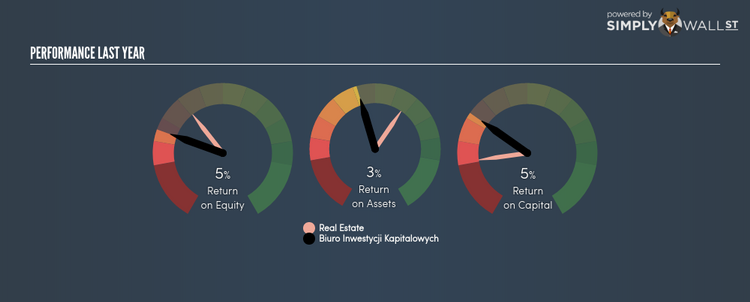How Did Biuro Inwestycji Kapitalowych SA.’s (WSE:BIK) 4.78% ROE Fare Against The Industry?

Biuro Inwestycji Kapitalowych SA. (WSE:BIK) delivered a less impressive 4.78% ROE over the past year, compared to the 9.90% return generated by its industry. Though BIK’s recent performance is underwhelming, it is useful to understand what ROE is made up of and how it should be interpreted. Knowing these components can change your views on BIK’s below-average returns. Today I will look at how components such as financial leverage can influence ROE which may impact the sustainability of BIK’s returns. Check out our latest analysis for Biuro Inwestycji Kapitalowych
Peeling the layers of ROE – trisecting a company’s profitability
Firstly, Return on Equity, or ROE, is simply the percentage of last years’ earning against the book value of shareholders’ equity. An ROE of 4.78% implies PLN0.05 returned on every PLN1 invested. While a higher ROE is preferred in most cases, there are several other factors we should consider before drawing any conclusions.
Return on Equity = Net Profit ÷ Shareholders Equity
Returns are usually compared to costs to measure the efficiency of capital. Biuro Inwestycji Kapitalowych’s cost of equity is 11.06%. This means Biuro Inwestycji Kapitalowych’s returns actually do not cover its own cost of equity, with a discrepancy of -6.28%. This isn’t sustainable as it implies, very simply, that the company pays more for its capital than what it generates in return. ROE can be broken down into three different ratios: net profit margin, asset turnover, and financial leverage. This is called the Dupont Formula:
Dupont Formula
ROE = profit margin × asset turnover × financial leverage
ROE = (annual net profit ÷ sales) × (sales ÷ assets) × (assets ÷ shareholders’ equity)
ROE = annual net profit ÷ shareholders’ equity
Basically, profit margin measures how much of revenue trickles down into earnings which illustrates how efficient the business is with its cost management. Asset turnover shows how much revenue Biuro Inwestycji Kapitalowych can generate with its current asset base. The most interesting ratio, and reflective of sustainability of its ROE, is financial leverage. Since ROE can be inflated by excessive debt, we need to examine Biuro Inwestycji Kapitalowych’s debt-to-equity level. Currently the debt-to-equity ratio stands at a balanced 105.04%, which means its ROE is driven by its ability to grow its profit without a significant debt burden.
Next Steps:
ROE is a simple yet informative ratio, illustrating the various components that each measure the quality of the overall stock. Biuro Inwestycji Kapitalowych exhibits a weak ROE against its peers, as well as insufficient levels to cover its own cost of equity this year. However, ROE is not likely to be inflated by excessive debt funding, giving shareholders more conviction in the sustainability of returns, which has headroom to increase further. Although ROE can be a useful metric, it is only a small part of diligent research.
For Biuro Inwestycji Kapitalowych, there are three pertinent factors you should further research:
Financial Health: Does it have a healthy balance sheet? Take a look at our free balance sheet analysis with six simple checks on key factors like leverage and risk.
Valuation: What is Biuro Inwestycji Kapitalowych worth today? Is the stock undervalued, even when its growth outlook is factored into its intrinsic value? The intrinsic value infographic in our free research report helps visualize whether Biuro Inwestycji Kapitalowych is currently mispriced by the market.
Other High-Growth Alternatives : Are there other high-growth stocks you could be holding instead of Biuro Inwestycji Kapitalowych? Explore our interactive list of stocks with large growth potential to get an idea of what else is out there you may be missing!
To help readers see pass the short term volatility of the financial market, we aim to bring you a long-term focused research analysis purely driven by fundamental data. Note that our analysis does not factor in the latest price sensitive company announcements.
The author is an independent contributor and at the time of publication had no position in the stocks mentioned.


